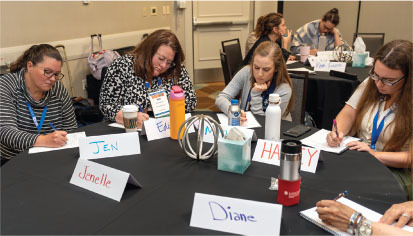July 2014
LEADING INSIGHT
Engineering Effective Change
BY DAVID SPUNGIN
 As a manager in an engineering firm, you’re a smart and practical problem solver who inspires trust in your team. All is going smoothly until one day you realize the need to promote or reassign a few team members. Or maybe it’s something more substantial like implementing a new information technology system. No problem. You will handle this like any other issue: acquire data, analyze options, design solutions, and, finally, implement the change. It all seems logical, and you are confident the process will yield success! Then it doesn’t. In fact, you encounter stiff resistance as people drag their feet to adopt your change initiative. What went wrong?
As a manager in an engineering firm, you’re a smart and practical problem solver who inspires trust in your team. All is going smoothly until one day you realize the need to promote or reassign a few team members. Or maybe it’s something more substantial like implementing a new information technology system. No problem. You will handle this like any other issue: acquire data, analyze options, design solutions, and, finally, implement the change. It all seems logical, and you are confident the process will yield success! Then it doesn’t. In fact, you encounter stiff resistance as people drag their feet to adopt your change initiative. What went wrong?
You are not alone. More than 70% of all organizational change efforts fail. While these failures occur for many reasons, consistent themes include attempting to solve adaptive challenges through technical problem solving and the common assumption that change can be managed to fruition. Engineering professionals often embrace these conventions when attempting to manifest change because they tend to value linear and systematic processes that enable a sense of control. Yet, changing human systems is habitually messy and unpredictable. Is it realistic to think that a formulaic change process might work?
As an analytical person myself, I have struggled with this question for years. My conclusion is that while a prescribed change framework might not be feasible, every change agent should consider several principles. Specifically, one must be mindful of: 1) preparing the system for change, 2) initiating the change using “soft energy,” and 3) sustaining the change through “hard energy.”
Preparing a system for change is an often overlooked but critical principle. Before engaging in change, one needs to understand where the system is starting from. What is the current state? Who are the key stakeholders? How might cultural norms and belief systems impact a proposed change? What is the perceived sense of urgency for change? These are just a few of the questions leaders must ask themselves. Yet, perhaps the most important preparatory question is, “Who stands to lose the most from this change?”
People don’t resist change, they resist loss. In particular, those who believe they may lose power and influence are the ones most likely to resist. Having thought through these questions and developed a compelling case for change, the savvy change agent will then secure buy-in from the highest sources of power in the system. Executive support helps in generating key alliances and centers of power to move the system in the desired direction.
Now that you have organizational muscle behind you, do the unexpected. Rather than imposing your change plan on the system, initiate the change by using “soft energy.” Soft energy is about acknowledging the difficulty of change and disrupting compassionately. This is also the energy of possibilities and emergence.
Start by inviting all key stakeholders into the change conversation. This process is often messy and unscripted. Facilitate the conversation and avoid directing it, while allowing for needs and concerns to be heard. Control must be abandoned in favor of faith. The more the group owns the change process, the more likely they are to take action. Soft energy also means understanding that change creates anxiety, and your role as the change agent should be to transform that angst. This is often accomplished by helping the system transition from fear to curiosity. Once a plan for change is agreed upon, constant and transparent communication of the vision is imperative for transformation to occur. When people “see” where they are going, they feel more in control and less anxious.
Finally, we also must implement a “hard energy” if we desire sustained change. Hard energy is challenging, focused, calculated, and persistent. This is the energy of driving toward closure. We do not forcefully coerce the system to change; rather we avoid distractions and measure performance. Organizations are what they measure, and the same principle applies to a change initiative. Thus, identify the metrics associated with change success early and monitor progress. Challenge the system to meet goals and objectives while using social pressure to pull the organization forward. Finally, reward early adopters accordingly and share examples of group success whenever possible.
While there may not be a way to truly “engineer” effective change, there are key principles that can increase your chances for success. By first preparing the system for change, one ensures an understanding of the politics, potential losses, and centers of power needed to generate momentum. By using soft energy, one disarms opponents with empathy and involves the system in determining its own solution. By using hard energy, one helps the group stay focused and on track as it embodies the change over time. I invite you, as an engineering professional, to master these tools of organizational change and lead your team to new heights of achievement.
David Spungin is an organization development consultant, leadership trainer, and executive coach. He holds a master’s degree in organization development and is the founder of The Leader Growth Group LLC. He can be reached at www.leadergrowthgroup.com.


 Volunteering at NSPE is a great opportunity to grow your professional network and connect with other leaders in the field.
Volunteering at NSPE is a great opportunity to grow your professional network and connect with other leaders in the field. The National Society of Professional Engineers (NSPE) encourages you to explore the resources to cast your vote on election day:
The National Society of Professional Engineers (NSPE) encourages you to explore the resources to cast your vote on election day:




